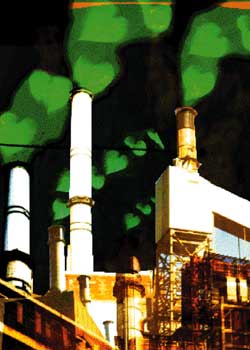

|
IT'S
NOT EASY BEING GREEN
Creating a single benign product for corporate use can present a
hurdle for environmentalists. McDonough and German chemist Michael
Braungart were asked by a client to come up with an environmentally
safe fabric. Initially, they looked at a hybrid made of cotton and
plastic from recycled beverage bottles, a solution that appeared
to make environmental sense. But a closer look revealed two problems:
when office workers moved about in their chairs, they roughed up
the fabric, sending tiny bits of recycled plastic into the air.
The plastic wasn't meant to be inhaled and, moreover, once it was
blended with cotton, the resulting fabric wasn't safe to biodegrade
in soil. Eventually, McDonough and Braungart settled on a fabric
made from pesticide-free plant and animal fibers--wool and ramie.
 Searching
out safe dyes and processing chemicals was the next challenge. Sixty
chemical companies declined to help before European giant Ciba-Geigy
signed on. With the experts on board, McDonough and Braungart considered
8,000 chemicals, rejecting 7,962. The remaining 38 compounds were
used to create a line of safe fabrics, including the non-toxic and
biodegradable fabric on the Lewis Center's auditorium chairs. The
seating fabric is not only edible (if anyone should be so inclined),
but degrades in sunlight in about three years. Searching
out safe dyes and processing chemicals was the next challenge. Sixty
chemical companies declined to help before European giant Ciba-Geigy
signed on. With the experts on board, McDonough and Braungart considered
8,000 chemicals, rejecting 7,962. The remaining 38 compounds were
used to create a line of safe fabrics, including the non-toxic and
biodegradable fabric on the Lewis Center's auditorium chairs. The
seating fabric is not only edible (if anyone should be so inclined),
but degrades in sunlight in about three years.Playing devil's advocate, ABC News correspondent and symposium moderator Robert Krulwich '69 asked McDonough, "Can you eat the fabric on the auditorium chairs?" "I
invite you to eat a chair," McDonough replied.
"Have
you eaten pieces of the fabric?" Krulwich persisted.
"Actually,
I have," McDonough said.
Eco-smart wastewater is another Lewis Center technology that may push its way into the corporate world. The Living Machine, created by John Todd, is a built-in wastewater system that imitates natural purification systems found in ponds and marshes. Bio-mimetics expert Janine Benyus says the system illustrates a new humbleness in our search for solutions to environmental problems. "Rather than turn to an engineering text, Todd asked how nature would filter water." The emerging science of biomimicry, she explains, seeks sustainable solutions by mimicking nature's designs and processes. New-age environmental thinking permeates the design of the Lewis Center. Simply put, it doesn't try to minimize environmental problems; it tries to eliminate them. The building is constructed using time-honored materials--brick, wood, and stone. Its windows open to allow in fresh air. Huge, old-fashioned eaves shut out the high summer sun. These are features you could find in 19th-century Ohio buildings constructed of non-toxic materials and designed for Midwestern weather. Even the desks are made of wood rather than man-made materials. For the first time in generations, students will be able to carve their initials in their desks. Thus, everything old is new again.
|
 The
Lewis Center was made possible largely by a gift from Adam
Joseph Lewis, a philanthropist and supporter of holistic
health efforts, international health programs, and a variety
of environmental issues.
The
Lewis Center was made possible largely by a gift from Adam
Joseph Lewis, a philanthropist and supporter of holistic
health efforts, international health programs, and a variety
of environmental issues. William
McDonough, founding principal of William McDonough + Partners,
Architects and Planners, was named TIME magazine's "Hero
of the Planet."
William
McDonough, founding principal of William McDonough + Partners,
Architects and Planners, was named TIME magazine's "Hero
of the Planet." Peter
P. Bihuniak is vice president of technology for BP Solar,
a leader in photovoltaic systems which turn sunlight into electricity.
Peter
P. Bihuniak is vice president of technology for BP Solar,
a leader in photovoltaic systems which turn sunlight into electricity. Environmental
educator David Orr chairs
Oberlin's environmental studies program.
Environmental
educator David Orr chairs
Oberlin's environmental studies program.